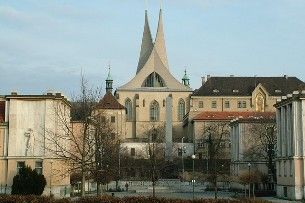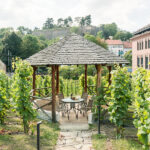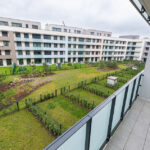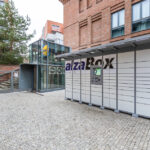The Emmaus monastery, the Benedictine monastery and the Church of the Blessed Virgin Mary, St. Jerome and Slavic Saints, or the Na Slovanech monastery. The church in Podskalí before the Vyšehrad castle, with its shell wings and gold-plated spikes has many historical names. But people in Prague call it simply “Emauzy” (Emmaus).
Why?
When the church was consecrated in 1372, a Gospel passage on the revelation of Jesus Christ to the disciples travelling to Emmaus was read there. Since then, the one-word name has caught on.
The architecture of the Emmaus Abbey
The monastery was built as part of the Prague New Town, and it cost as much money as the Charles Bridge. Today’s visitors can see the cloister, decorated with a cycle of 85 biblical themes from the 14th century, the Baroque refectory, the Imperial Chapel, and the church dedicated to the Blessed Virgin Mary, St. Jerome and Slavic Saints (Cyril and Methodius, Vojtěch, and Prokop). The monastery was built near the chapel of St. Cosmas and Damian with a Baroque vault, located in the northwest corner of the campus.
The Benedictines in Emmaus
The Emmaus monastery was founded by King (and Emperor) Charles IV in 1347. It was built for the Slavic Benedictines to help them cultivate the Old Slavic church liturgy and study the biblical languages. The oldest Christian monastic order, governed by the monastic orders of St. Benedict of Nursia from the early 6th century, can be still found here. At the time of the reign of Charles IV., the Benedictine Abbey was the only Slavic monastery in Western Europe.
During the Hussite period, it was the only Czech monastery practicing the communion under both kinds which was the main symbol of the legalization of two faiths in the Czech lands. That’s why the monastery was not plundered and could keep its position of a learning centre although it was taken over by the Utraquists in 1410.
Cruel penalty for the Nazi resistance
During the World War II, the monastery served as a shelter for active Resistance fighters. From here, the radio telegraphists from the Nation’s Defence organisation informed the Russian intelligence service about the situation in Prague. In 1941, before the Nazis closed the church to the public, a mass was celebrated there to express the resistance to the occupiers. The Gestapo, however, scattered the believers and forced the faithful monks to leave the monastery. The abbot, Arnošt Vykoukal, was arrested and sent to the concentration camp in Dachau where he died after more than a year.
When the Allies were bombing Prague in 1945, the Emmaus Monastery and the church were hit by three incendiary bombs. Most of the vaults, the two Gothic church towers and other parts of the buildings burned out. Extensive repairs were carried out in the 1950s, when the monastery complex was handed over to the Czechoslovak Academy of Sciences. The order of the Benedictines returned to the monastery thanks to the restitution after the Velvet Revolution in 1989.
How to get there
The two typical towers of the Church of the Blessed Virgin Mary will guide you to the monastery, whether you come from the Vltava river banks, or from the city centre. Take a tram to Palacký Square, can cross Pod Emauzy Square and go to Pod Slovany Street. The entrance to the premises of the historical buildings can be found at the end of Na Slovanech Street.
If you are coming by the underground, take the yellow B line, get off at the Karlovo Square station and use the moving stairs leading to Palacký Square. If you get off at the opposite side of Karlovo Square, you’ll walk a little longer: go to Vyšehradská Street and turn right to Na Slovanech Street.
Please know that the monastery is closed to the public on Sunday.





